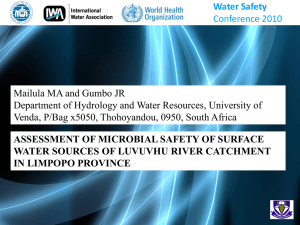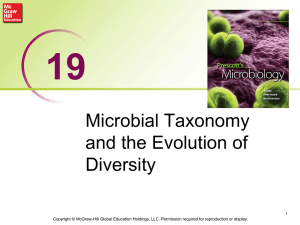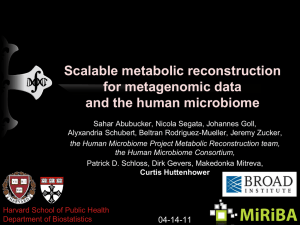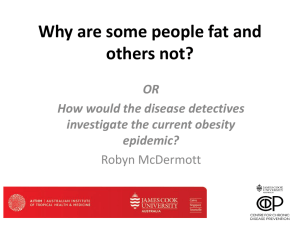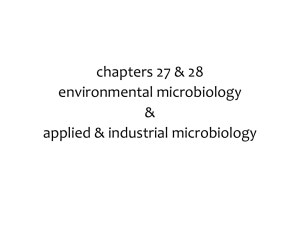Can Germs Help?-David N. Cornfield, MD
advertisement
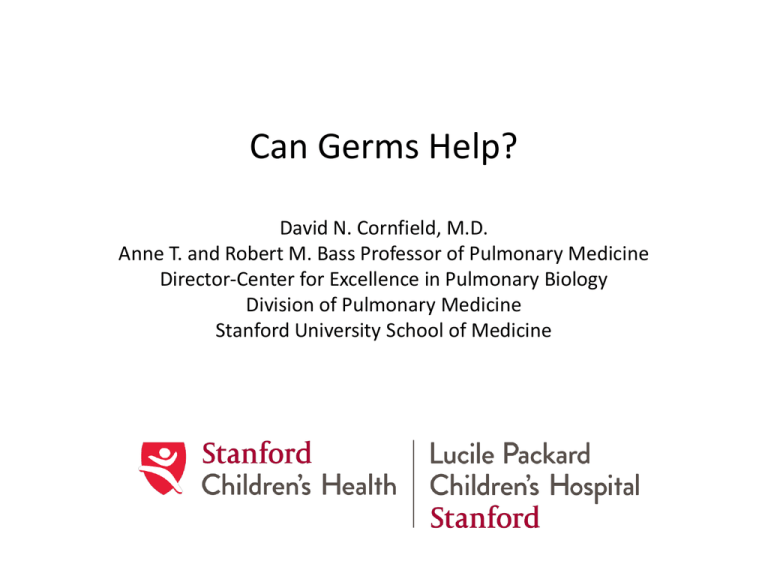
Can Germs Help? David N. Cornfield, M.D. Anne T. and Robert M. Bass Professor of Pulmonary Medicine Director-Center for Excellence in Pulmonary Biology Division of Pulmonary Medicine Stanford University School of Medicine biological diversity and the importance of microbes three-domain tree of life based on ribosomal RNA gene sequences: Woese, Kandler, and Wheelis, PNAS, 1990 — most genetic diversity in the tree of life occurs among microbes — this diversity exists in polymicrobial communities, and is difficult to access (dark matter) — < 1% of microbes have been grown in the lab — microbes run Earth’s biogeochemical cycles, and outnumber human cells in the body — much of the human microbiome remains uncultivated — cultivation-independent techniques like metagenomics and single-cell approaches are needed to study microbial systems Human Airway Microbial Ecology — work on microbes in the lung has focused on pathogens cultured from states of disease — cystic fibrosis (CF) is a common autosomal recessive disorder (30,000 patients in US) — caused by mutations in the gene encoding the CF transmembrane conductance regulator (CFTR) — among the manifestations of CF, mucociliar clearance is disrupted, leading to chronic lung infection with microbial biofilms — recently, metagenomic studies identified complex microbial communities in the CF lung — what is the health impact of these organisms? figure, wikipedia commons Bacteria in lungs of CF patients by age CFF Registry, 2012 Paradigms of Pulmonary Infection conventional paradigm of microbial ecology in CF pathogenesis pathogenesis healthy CF-early life/ stable CF-later life/ exacerbated Paradigms of Pulmonary Infection hypothesis: a healthy microbial ecology of the lung? pathogenesis “. . . but virtually nothing is known about the microbiome of the lung. Indeed, the presence of a lung microbiome in normal individuals has yet to be established conclusively.” - abstract of a recently funded NIH R01 healthy CF — Does a healthy pulmonary microbiome exist? — clinical cultures for pathogens often negative, (although reports of bacterial rRNA sequences exist) — Human Microbiome Project: no pulmonary sampling • Are we missing the big picture in microbial ecology of the lung? Lung Study: subject and sample characteristics Deeply probe pulmonary microbial population using 16S ribosomal gene sequencing — 454 DNA pyrosequencing of the V4 region, 103 – 105 sequences per subject — each 16S read serves as a phylogenetic ‘name tag’ for the source organism Induced sputum collected from 9 healthy control individuals (CT) & 16 CF patients — Methodology: — — — — DNA extraction: bead beating, enzymatic digestion, DNeasy prep PCR with barcoded 454 fusion primers (454A-barcode-515F, 454B-1391R) quantification by the ultrasensitive and accurate digital PCR method* classified quality-filtered sequences using Ribosomal Database Project tool *digital PCR method for library quantification: White, Blainey, & Quake, et al, BMC Genomics 2009 CF study: Blainey, Milla, Cornfield, & Quake, Science Translational Medicine 2012 Phylum-level classification — CF cohort not dominated by cultured pathogens (mostly Proteobacteria) — (Pseudomonas, Haemophilus, Burkholderia) Blainey, Milla, Cornfield, & Quake, Science Translational Medicine 2012 Phylum-level classification — CF cohort not dominated by cultured pathogens (mostly Proteobacteria) — — — — — (Pseudomonas, Haemophilus, Burkholderia) healthy individuals harbor a complex, endemic, pulmonary microbiome control cohort appears richer, more even control enriched for Bacteriodetes (p = 0.04*) CF enriched for Actinobacteria (p = 0.01*) *p-values are Bonferroni-corrected for multiple testing Blainey, Milla, Cornfield, & Quake, Science Translational Medicine 2012 Cohort analysis: Phylum level p = 0.001 p = 0.02 p = 0.01 A = number of GOLD genomes and projects for the taxon and B = number of GOLD genomes and projects in the domain • Higher diversity at phylum level in healthy control cohort • Greater abundance of ‘dark matter’ (uncultivated organisms) in healthy control cohort – uncultured phyla are enriched TM7 (p = 0.01*), and SR-1 (p < 0.001*) *p-values are Bonferroni-corrected for multiple testing Blainey, Milla, Cornfield, & Quake, Science Translational Medicine 2012 personal pulmonary microbiomes Principal Components Analysis (PCA) • Both cohorts show strong inter-individual variability—how to look for characteristic patterns? PCA transforms high-dimensional data to a new set of coordinates allows representation of the dataset variation in a smaller number of dimensions reveals hidden or composite control variables PCA figure, Wikipedia Blainey, Milla, Cornfield, & Quake, Science Translational Medicine 2012 principal components analysis (PCA) of microbial family abundances (96% seqs classified with confidence >80% ) 100 bootstraps of 1000 sequences are plotted for each subject to sample error distribution CF cluster holds in PC1-PC3 — microbial ‘signature’ of CF microbiome identified, despite inter-individual variation — healthy subjects are more diverse on an individual bases, AND more distinct from one another Blainey, Milla, Cornfield, & Quake, Science Translational Medicine 2012 principal components analysis (PCA) of microbial family abundances 100 bootstraps of 1000 sequences are plotted for each subject to sample error distribution — microbial ‘signature’ of CF microbiome identified, despite inter-individual variation — healthy subjects are more diverse on an individual bases, AND more distinct from one another Blainey, Milla, Cornfield, & Quake, Science Translational Medicine 2012 principal components analysis (PCA) of microbial family abundances * * 100 bootstraps of 1000 sequences are plotted for each sample to show statistical placement margins * * dark matter index = 1 — microbial ‘signature’ of CF microbiome identified, despite inter-individual variation — healthy subjects are more diverse on an individual bases, AND more distinct from one another Blainey, Milla, Cornfield, & Quake, Science Translational Medicine 2012 principal components analysis (PCA) of microbial family abundances ** * ** * 100 bootstraps of 1000 sequences are plotted for each sample to show statistical placement margins * * dark matter index = 1 families with cultured ‘CF pathogens’ * — microbial ‘signature’ of CF microbiome identified, despite inter-individual variation — healthy subjects are more diverse on an individual bases, AND more distinct from one another Blainey, Milla, Cornfield, & Quake, Science Translational Medicine 2012 principal components analysis (PCA) of microbial family abundances ** * * * ** * * 100 bootstraps of 1000 sequences are plotted for each sample to show statistical placement margins * * dark matter index = 1 families with cultured ‘CF pathogens’ CF-associated families lacking known CF pathogens * — microbial ‘signature’ of CF microbiome identified, despite inter-individual variation — healthy subjects are more diverse on an individual bases, AND more distinct from one another Blainey, Milla, Cornfield, & Quake, Science Translational Medicine 2012 principal components analysis (PCA) of microbial family abundances ** * * * ** * * * 100 bootstraps of 1000 sequences are plotted for each sample to show statistical placement margins Table 1. Summary of CF subject characteristics. * * Age in years (mean ± SD) 28.14 ± 7.23 Gender 10 Male : 6 FVC (mean ± SD) 3.88 ± 0.60 dark matter index = 1Liters families with cultured%-Predicted ‘CF pathogens’ 85.65 ± 8.9 CF-associated families lacking known CF pathogens FEV1 (mean ± SD) Liters 2.72 ± 0.54 %-Predicted 71.89 ± 12.7 CFTR genotype Δ/Δ 7 Δ/other 4 Other/Other 2 disease or antibiotic treatment? Sweat Chloride (mmol/L) 97.40 ± 29.2 Chronic Antibiotic Therapy (not mutually exclusive) Oral Azithromycin 9/15 Inhaled Tobramycin 8/15 Inhaled Colistin 5/15 Oral Dicloxacillin 1/15 Oral Levofloxacin 1/15 No Antibiotic 3/15 — microbial ‘signature’ of CF microbiome identified, despite inter-individual variation — healthy subjects are more diverse on an individual bases, AND more distinct from one another Blainey, Milla, Cornfield, & Quake, Science Translational Medicine 2012 CF pulmonary microbiome/clinical correlates p = 0.02 • microbial diversity declines over life course of CF patients (Lynch et al, Pone, 2010) • within our adult cohort, phylum-level diversity correlates significantly with inflammation, decreased diversity, increased inflammation – not with pathogens, antibiotic treatment status, or patient age – this association suggests a possible link between microbial ecology and etiology of CF use as diagnostic/prognostic tool? • healthy pulmonary microbiome more diverse than that CF pulmonary microbiomes Part I: conclusions • contrary to conventional wisdom, each of us has a complex & personal pulmonary microbiome – biological dark matter is abundant in healthy and CF lungs • a focused microbial ‘signature’ of CF exists, characterized by a patterns of microbial diversity – new targets for antimicrobials – new candidate taxa for probiotic therapy • microbial diversity is associated with inflammation in our adult cohort future work: investigating Rothia-Pseudomonas interaction – Rothia species seem to be overlooked players in CF (abundant & diseaseassociated) – significant negative correlation between Rothia and Pseudomonas (r = 0.56) – cultured Rothia and Pseudomonas species are known to form biofilms – parse competition between these organisms using microscopy and RNAsequencing

